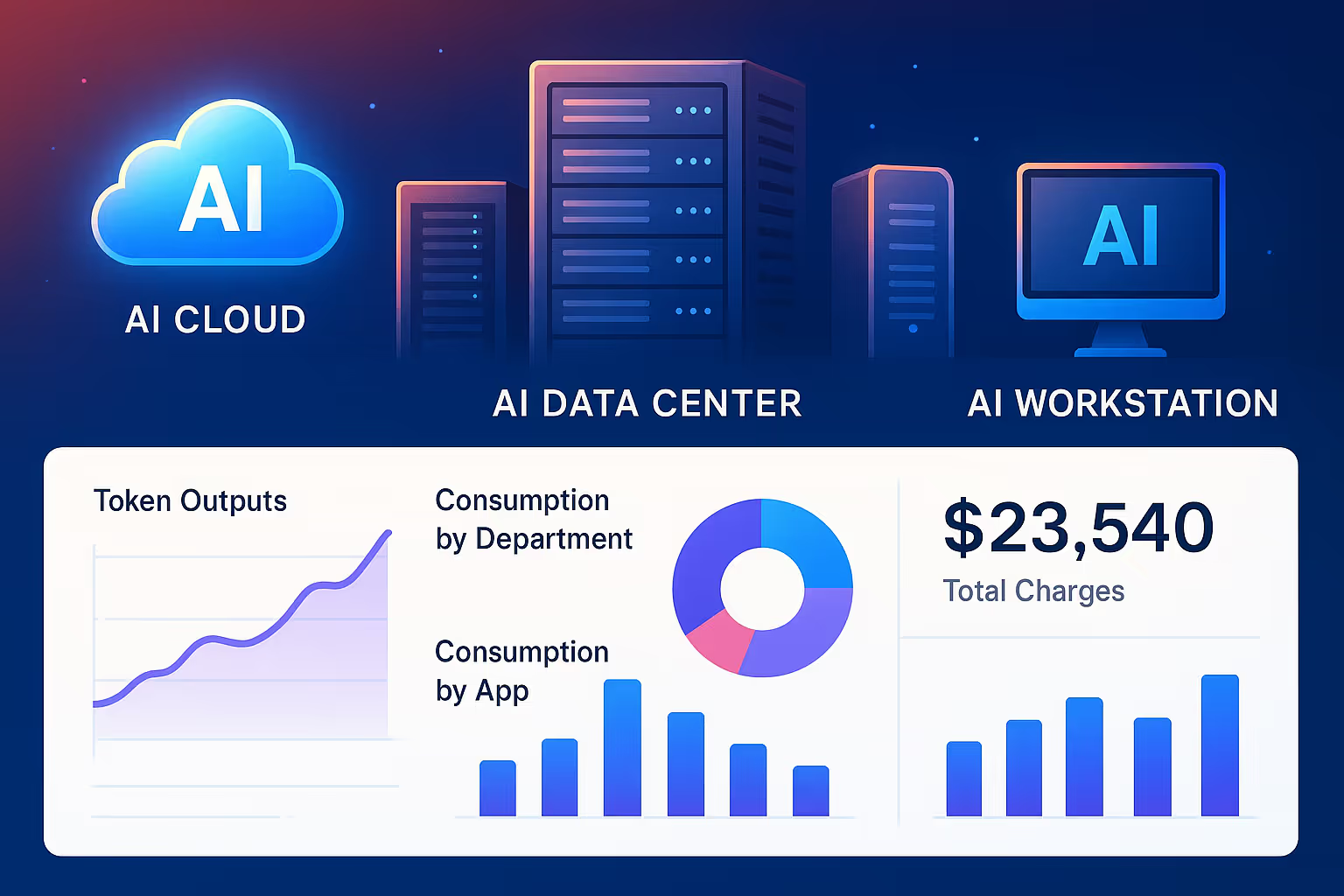About 35% of businesses use AI in some capacity. Most of that AI usage is in the form of Generative AI large language models (LLMs). Software companies are starting to leverage tools like ChatGPT in their applications to add unique services to their customers.
In this article, we’ve gathered a few ideas on how to incorporate AI into your business model in a way that will generate revenue. But here's the more pressing question to address first: how can you appropriately price these new applications?
Too many companies are showing up to the gold rush without a shovel. They’re trying to leverage AI to keep up with the competition while only being equipped to charge flat subscription fees for these services.
Many are losing money to pay companies like OpenAI for tokens. When their customers get excited and start using their AI services heavily, they run up infrastructure costs faster than service providers can respond.
The foundation to solving this problem is instrumenting usage-based metering of your LLMs. This allows you to monitor how much you’re spending on AI services down to the tenant or user level, learn which customers are using the service and how they’re using it, and design fair pricing plans that are tied to value.
With Amberflo, you can meter AI consumption, construct dynamic pricing plans, and gain real-time visibility into customer usage.
First, let’s take a closer look at the three pillars of AI monetization. Then, we’ll examine software solutions that can help you strategically monetize AI as you scale your business. Our processes and tools can be applied to each of them.
The Three Pillars of AI Monetization
AI's core strength lies in its ability to process, analyze, and interpret vast amounts of data faster and more accurately than humans.
Now that so many companies are comfortable using AI to improve their internal processes, they're turning their attention outward to find ways to benefit their customers.
AI's capability can be leveraged in numerous ways for monetization. But, it needs to be democratized, allowing both innovators and enterprises to profit. By emphasizing fairness, transparency, and alignment between service provider profit and customer value, everyone wins.
Here are the three pillars of any monetization plan.
1. Usage Metering
Highly granular usage metering tracks all service-level consumption. This includes input and output tokens of the LLM, along with other backend infrastructure such as file storage, vector databases, web hosting, and other components needed to deliver the service.
Doing this requires highly scalable data pipelines capable of ingesting thousands of records each second, deduplicating and managing idempotency, and allowing for a wide variety of metadata tags that can be applied in real time.
To have a complete picture of the costs each user imposes on your system, every request needs to be metered. Without a solid, accurate, and real-time metering pipeline tracking each activity from dozens of services, it’s impossible to accurately forecast costs or bill customers fairly.
2. Quoting (CPQ) and Forecasting
Price forecasting anticipates usage and generates a quote based on the given usage volume according to a set pricing plan. The anticipated usage can be plugged into the pricing plan to generate a quote and, once accepted, the quote becomes a contract.
There are a couple of different strategies you can take from here: the quote can serve as the basis of pricing negotiations on volume discounts, or a pricing calculator can be made publicly available to allow customers to estimate their costs when signing up for a freemium product in a product-led growth style (PLG) motion.
In the enterprise SaaS model, quotes are often negotiated back and forth and, when accepted, parlayed into a long-term contract. That contract may have a variety of nuances that the billing plan needs to respect, such as custom overage rates, payment schedules, drawdown periods, rollover logic, etc.
Over time, customers need to be able to view their usage reports and see how it compares to the anticipated usage and contracts. This is vital to earning the trust of a buyer under a usage-based contract. If they’re using more than the anticipated amount, they may be able to renegotiate the contract to obtain a larger discount for future usage.
Conversely, if usage is lagging behind the anticipated volume, they can take action to increase adoption or engage with support to understand any outstanding issues with their team’s usage. This ensures there are no surprises when the bill is due.
3. Modern Billing
The final piece of the puzzle is a modern billing solution that can accurately invoice usage and charge each customer based on their payment plan for the generative AI service.
This is where the art of deal-making meets the science of measurement. For strictly technical use cases, companies may choose to bill customers in a Cost+ model where a fixed margin is added on top of the true cost to deliver the service. It can be metered by something as granular as LLM tokens so everyone feels the price is fair.
On the other hand, companies may understand that the value a user gets from the AI service is not correlated to the number of tokens. Rather, it may be related to some other outcome such as flights booked at a discount, or customer support tickets resolved without a human.
This is where companies that have their cost basis well in hand are at an advantage. If you have profiled your users and know the distribution of your costs, you can price to value confidently knowing that even your most demanding users will remain profitable.
Companies that win here will offer users a variety of pricing plans and notice which ones they prefer. They should be able to create flexible plans, combining usage-based, seat-based, and fixed-rate elements as needed. The billing service must leverage the metering service which tracks usage to then apply the rating (pricing) logic in real-time to generate metered invoices.
Customers and users alike must be able to see the up-to-date invoice balance at any point in a billing cycle to guarantee maximal fairness and total transparency in billing.
AI-Driven Software Solutions
With these three pillars in place, the only question that remains is how to turn these strategies into revenue. One of the most lucrative approaches to monetizing AI is developing and licensing AI-driven software solutions to other businesses.
Companies with strong AI expertise can create specialized software tools that leverage AI algorithms to solve specific industry challenges or automate complex processes.
These solutions can be offered on a flat subscription basis or through a usage-based licensing fee, generating recurring revenue.
Here are a few prime examples.
- Offer AI Data Analytics Services
- By leveraging AI algorithms to process and interpret large volumes of data, you can uncover valuable patterns, predict trends, and provide actionable recommendations to your clients, charging a premium for your expertise.
- Generate High-Quality Content
- These tools can generate articles, product descriptions, social media posts, and other forms of content that are engaging, informative, and optimized for search engines.
- Offer them to clients on a flat subscription basis, an up-charge to current pricing plans, or charging per piece of AI-generated content.
- Personalize Marketing Campaigns
- AI algorithms can identify individual preferences, behaviors, and purchasing patterns, allowing you to deliver customized marketing messages and product recommendations.
- This level of personalization can significantly improve customer engagement, conversion rates, and overall marketing ROI. Pricing models here can range from seat-based licenses to even a % of additional revenue driven from the campaign (made possible by analytics instrumentation).
- Integrate Into Existing Applications
- A customer relationship management (CRM) system can be enhanced with AI-powered sentiment analysis to automatically detect and prioritize high-value leads based on their interactions with the company.
- Similarly, a project management tool can use AI to optimize resource allocation, predict potential delays or bottlenecks, and suggest corrective actions in real time. Additions like these are prime examples of AI being leveraged to create new tiers in traditional pricing plans, or being monetized on value metrics such as the number of projects being actively managed.
- Offer AI Consulting Services
- AI consulting services can range from strategic planning and roadmap development to technology selection and implementation support.
- In these types of arrangements, it’s important to design a contract where the price of AI services is included. Otherwise, agencies might be left holding the bag when usage takes off faster than anticipated in an account. Being able to accurately measure and bill customers based on their usage of GenAI tokens in addition to traditional consulting hours is a must.
- Develop AI Training Programs
- These programs can range from introductory courses that provide a high-level overview of AI concepts and applications to more advanced workshops that dive deeper into specific AI techniques and tools.
- Training providers can reach a wide audience and cater to different learning styles and preferences.
- They can also partner with educational institutions and professional associations to develop certified AI training programs that provide participants with recognized credentials and career advancement opportunities. Such services are perfect for usage-based monetization where students and companies pay based on the number of course modules they interact with.
The Future of AI Monetization in Business
Monetizing AI isn't rocket science, but it does take some strategic thinking and planning. By solving real problems, offering unique value, and finding the right pricing model, you can turn AI into a profitable asset for your business.
The key is to start small, test and iterate, and always keep your customers' needs at the forefront. With the right approach, AI can be a game-changer for your bottom line. There’s no need to be scared of your OpenAI bill every month!
Amberflo has predefined metrics, cost measurements, billing, and invoicing capabilities for the leading LLMs and AI chatbots. Together, we can help you figure out the right pricing or cost-tracking strategy as you continue to monetize AI.
Talk to an expert today to see how you can develop your personalized strategy for success.
Read the full article on Forbes here!





.svg)

